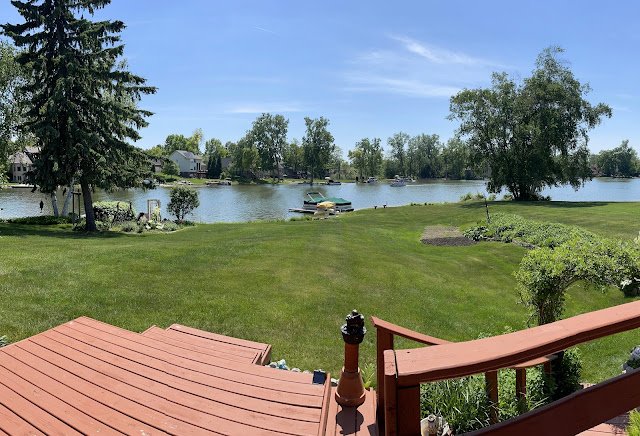An afternoon at Tull Lake
Tull Lake is a man-made lake in the White Lake Charter Township in Michigan. A day after Ninang Trining's birthday, we drove over to visit Kuya Lemuel and Ate Adora. They have a house by this lake and invited us Californians over to experience riding a pontoon around the lake.

Their house is a back split-level home. From the front, the house seemed to have one level. However, the backyard is sloping, with outdoor stairs from the deck leading to the lake on one side, and a lower level visible on another. The deck is equipped with lounge chairs. Mommy certainly had a field day relaxing on the deck.
The backyard was huge! My son found a patch of garden soil very interesting and spent a good hour there. He had fun putting soil into a toy bus that we discovered during our exploration of the backyard. In the process, he also smeared soil all over his face and clothes; but no matter because he had such a wonderful time playing.

The highlight of our visit was the boat ride around Tull Lake. The lake has several bays and three islands, reminding me of Caliraya Lake in Laguna. Tull Lake is a limited all-sports lake, which means that people who go boating here aren't allowed to use jet skis and there is a cap on the size of boats and their motors. Though the conditions were perfect for wakeboarding, I doubt that it's allowed on the lake because of the speed limits imposed on boats.
We definitely had fun touring the lake while riding Kuya Lemuel's pontoon (a flat-bottom boat). He showed us around the Twin Lakes neighbourhood. The houses were palatial and each had its own quay. There was ample shade along the route we took so it wasn't as sunny as I had expected our boat trip to be.
Tull Lake is pretty shallow but since my son is a toddler, he needed to wear a life vest. He initially refused but relented when he saw me wearing a life vest. I guess that this safety first habit I developed when I was wakeboarding, and it is a value that I am going to try and ingrain in him.

I had thought that the nice afternoon on the lake was the best memory I could have from this trip. Instead, I found the view of my son sitting on a bench by the lake with my parents and with Ninang Trining to be even more compelling. He is spending quality time with his grandparents and grand-aunt; not a lot of kids have that opportunity. Though he's not old enough to understand many of the stories being passed as an oral tradition, he is being exposed to them. Similar to me hanging out with Lola Bats, learning the stories about my paternal side of the family. I believe that knowing his roots is beneficial for my child especially because he is a third culture kid. Kids who grow up in a culture different from their parents develop a "cultural hybrid" of sorts that may cause difficulty in developing a sense of belonging or identification with a culture. In my son's case, because he's biracial, he will have to develop a more complex cultural hybrid in which he finds meaning in being Asian and African while growing up as a North American. Having strong links to his ancestors is a good way to start.

At last, our time on Tull Lake has come to a close. Such a beautiful day on the lake, getting to know Ninang Trining's close friends and family in Michigan.

Comments
Post a Comment
Thank you for dropping by!
Before moving on, please share your thoughts or comments about the post. :)
Thanks again!